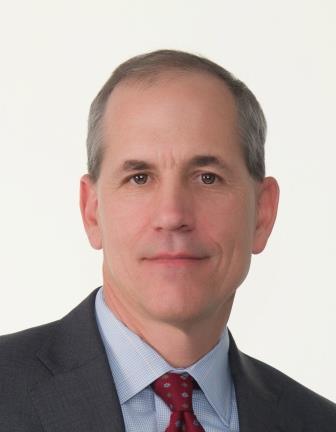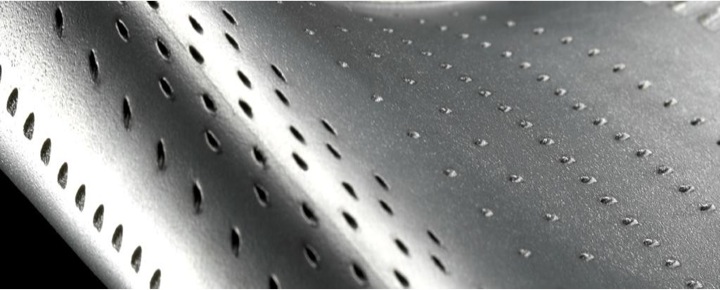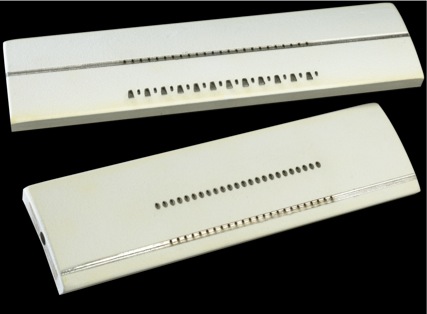Metem: Energizing the Economy and Advanced Manufacturing

As the world moves toward greater use of natural gas for electricity generation, giant turbine engine manufacturers are continually pursuing more efficient, cleaner, and productive turbines for power plants.
The mission of Metem Corporation is to help make these engines run hotter and longer, thereby producing more power with lower emissions. Metem achieves this through highly engineered processes that drill cooling holes into turbine engine parts, to provide targeted, precise airflow. This increases the life and efficiency of the turbine engines and contributes to lower energy costs and emissions.
Metem’s pioneering work in this field includes advanced applications in Electrical Discharge Machining (EDM) and Electro-Chemical Machining (ECM). The company also serves the aerospace industry. Through a joint venture with ECM Technologies of The Netherlands and related research and development, Metem is also assessing an array of potential new markets.
Steven Goldthwaite, President and CEO of Metem, has led the company to over $50 million in annual revenues, with 280 employees across three locations in New Jersey, Pennsylvania, and Hungary. He is also an advocate for the U.S. being the center of advanced manufacturing, a promoter of STEM education, and committed to continuous innovation.
We recently sat down with Steven to discuss these issues.
Tell us a little bit about Metem. What are the origins of the company and how has it evolved over time?
 Steven: Metem is an exciting business in a fantastic industry. We were founded in 1962 by my father in one of those classic entrepreneurial family start-up stories. He was a very inventive guy and he always wanted to do things that other people didn’t want to do. He was very interested in creating advanced technology around metal working. There was high growth in aerospace and, at that time, manufacturing was booming throughout America. He chose to focus in what was, and today still is, a niche market - drilling cooling holes in turbine engine parts. We were one of the first companies in the world to drill these cooling holes. We did it back then and still do it today using Electrical Discharge Machining (EDM) and Electro-Chemical Machining (ECM).
Steven: Metem is an exciting business in a fantastic industry. We were founded in 1962 by my father in one of those classic entrepreneurial family start-up stories. He was a very inventive guy and he always wanted to do things that other people didn’t want to do. He was very interested in creating advanced technology around metal working. There was high growth in aerospace and, at that time, manufacturing was booming throughout America. He chose to focus in what was, and today still is, a niche market - drilling cooling holes in turbine engine parts. We were one of the first companies in the world to drill these cooling holes. We did it back then and still do it today using Electrical Discharge Machining (EDM) and Electro-Chemical Machining (ECM).
Now we’ve evolved that technology into large land-gas turbine components for power generation. We’re a wonderful example of a company with a long history and legacy. Because we’ve brought innovative technology to the market and concepts about how we can be a global company, we have grown and succeeded.
With the very specialized type of drilling that you do, are there many other companies out there in the market that do this type of work? If so, what sets you apart from them?
Steven: Every company has competition in every market and with every service. We address that first and foremost by building deep and durable long-term relationships with our customers and collaborating closely with them.
The other key element that really differentiates us is building a true culture of continuous innovation. The question is – how do we really do that? I have led several successful information technology companies. This has helped me lead Metem because when a middle market manufacturing company brings the confluence of technology and manufacturing together, it is very powerful. Many large companies do this – they’re doing it to bring information technology right to the forefront to understand their processes and products better.
How do you view Metem’s business outside of the US? Is international expansion a priority?
Steven: In 2005 we chose to open a plant in Europe, Hungary specifically, as an avenue for growth. We didn’t go into Hungary because we needed to move into a low-cost country or find inexpensive labor. We went there because we wanted to expand into the global market. And it worked. I think that’s an important distinction for the leaders of middle market companies to really understand. It’s not about approaching globalization as a way to find low-cost labor, but rather as a place to find new markets. We’ve continued that globalization theme in 2012 by acquiring 50% of ECM Technologies, a research and development firm in The Netherlands.
What was core to our success in Hungary was the leader of our facility. He is a Hungarian national that we promoted very quickly through our organization. That was one of the best decisions that we made. The message to middle market companies is that as you move into these markets, you need to build an organization that has the culture that works within that local environment. We shouldn’t try and layer our business culture and practices on top of theirs.
Technology protection is also very important. I’ve always believed that middle market companies need to continually develop technology, create the methods to protect that technology, and as they move to a global environment, they need to think about technology protection in new ways.
What innovation investments do you see as critical to the business?
Steven: Investment in innovation is critical. We constantly have to be investing into state-of-the-art equipment. There’s a real question about how to foster innovation and accelerate product development. I’ve worked with our teams to tell our customers that we can innovate faster by getting closer to your business, releasing imperfect solutions to you early, have us both learn from those, and then pivot. That has helped us immensely with our customers. When you have these deep customer relationships, you can have enough trust to give them ideas that are not fully developed, try them out, take them to new levels, and make sure they work quite well.
 We’re continually investing in new ways to create these cooling holes. We are innovating around our existing technology and looking at how we can modify processes to do things faster and better. We’re looking at how we can use IT to provide information so that our operators can know what’s happening with that machine tool in real-time. We’re also looking at disruptive technologies – what is 3D printing doing and what kind of opportunities does it bring to manufacturing?
We’re continually investing in new ways to create these cooling holes. We are innovating around our existing technology and looking at how we can modify processes to do things faster and better. We’re looking at how we can use IT to provide information so that our operators can know what’s happening with that machine tool in real-time. We’re also looking at disruptive technologies – what is 3D printing doing and what kind of opportunities does it bring to manufacturing?
We also have a new technology coming to market that we chose to patent. Companies need to evaluate what technologies they should patent and what technologies they should protect through trade secrets. Those are very important for middle market companies who are inventing and innovating. One of the reasons we purchased 50% of ECM Technologies is that we wanted to bring their technology into a production environment. But we also wanted to reach out and find teams of scientists that are doing the most advanced work in an area of our business.
Let’s shift gears for a minute and talk about your employees. What skill-sets are you actively recruiting for and how do you help employees further develop skills over time?
Steven: I predict that every middle market executive would say that one of their biggest challenges is recruiting the right talent. We’re addressing that through the expanded internship program. My advice is to expand your internship program and relationship with universities. It will be a hotbed of talent and a feeder initiative for new people.
We want people that come from many different backgrounds. They don’t necessarily need to be engineers that specialize in our field, because we’re willing to train them. In my opinion, companies need to be very open in terms of the skillsets they are seeking. I’ll hire an engineer or a person that’s in a totally different industry if they have the right skills – the enthusiasm, the work ethic, the core STEM education, the will to work collaboratively. Those people are sometimes hard to find. We need lifelong learners and people that are open to change. But we also need individuals that respect and understand the legacy and history of our business. For someone to be successful and to shape our organization, they have to have an awareness that there were hundreds of very bright people that came before them that helped build what we have today.
I think that there’s tremendous opportunity for young people in middle market companies and that these companies should fast-track young executives very quickly. Within the right company, the leaders of that organization will recognize that they need new ideas and young talent in the leadership of the organization. At Metem, for example, our leadership team is comprised of several individuals in their 40’s and other industry veterans. I came to be CEO of this company when I was fairly young – I was 36 – but I recognized that you need to give young leaders more responsibility sooner than you might at first think you should, trust their instincts, let them make mistakes, and help them grow. When you do this, the benefits are immense.
In your opinion, what is the role of STEM (Science, Technology, Engineering, and Mathematics) within the US economy? What are the prospects for it in the future?
Steven: STEM is really important and business leaders need to take on STEM leadership.
At Metem, we do that by having a very robust internship program. We bring students – high school and college – into our organization and put them into programs that are valuable to both them and us. That’s something I would highly recommend any middle market company do. Identify a leader within your organization, preferably one of your younger executives, to lead an intern program and have students see the real practical application of science, technology, and engineering.
The next giant industries of growth, I believe, will be around advanced manufacturing and bioengineering. It’s very exciting. The US government can certainly do more, but it’s our responsibility as business leaders to bring young people into our organizations and help them get excited about what it really means so they can then develop and pursue careers.
What advice do you have for other middle market executives looking to grow their business?
Steven: One of the themes that has been important to our success, and what I think is important to middle market companies overall, is specialization in technologies, markets, and services that you can succeed at better than anybody else. You need to focus at being best in the world at something and build on that.
Middle market firms also need to be creating joint ventures and partnerships with researchers and universities. Every middle market company should have a thriving internship program with one or two universities where they’re working with students and professors to help develop technology. We have a team of MBA students doing market research for us on applications of ECM and some other advanced technology research.
What’s the next great frontier for Metem? Where do you see the company in the next five years?
 Steven: We’re extremely excited about our investment in ECM Technologies. Electro-Chemical Machining is really all about machining at the molecular level. We’re able to create shapes and features that could never really be done before. Design engineers, whether you’re making an iPhone or a new jet engine, are trying to make things lighter, faster, and better able to work in more corrosive environments. We’re super excited about what our non-conventional ECM processes can do.
Steven: We’re extremely excited about our investment in ECM Technologies. Electro-Chemical Machining is really all about machining at the molecular level. We’re able to create shapes and features that could never really be done before. Design engineers, whether you’re making an iPhone or a new jet engine, are trying to make things lighter, faster, and better able to work in more corrosive environments. We’re super excited about what our non-conventional ECM processes can do.
I expect we will also be expanding our aerospace work. We have a long history in aerospace coupled with tremendous growth potential there. There also continues to be a lot of opportunity in the power generation sector. We’re going to use the most advanced machining technologies in the world to machine some of the most advanced components on turbine engines. We’re going to do that by building highly advanced manufacturing centers within our factories. That will create tremendous efficiency so that we can bring these products to market and offer significant value to our customers throughout the world.